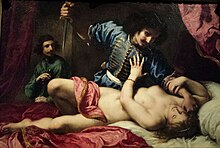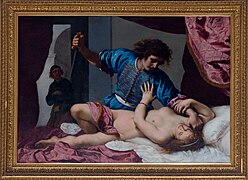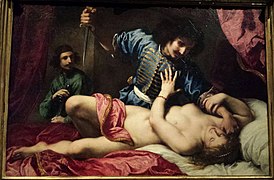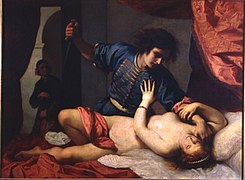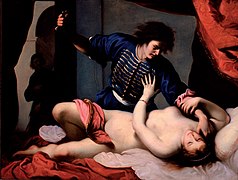
Lucius Tarquinius Superbus was the legendary seventh and final king of Rome, reigning 25 years until the popular uprising that led to the establishment of the Roman Republic. He is commonly known as Tarquin the Proud, from his cognomen Superbus.

According to Roman tradition, Lucretia, anglicized as Lucrece, was a noblewoman in ancient Rome. Sextus Tarquinius (Tarquin) raped her. Her subsequent suicide precipitated a rebellion that overthrew the Roman monarchy and led to the transition of Roman government from a kingdom to a republic. After Tarquin raped Lucretia, flames of dissatisfaction were kindled over the tyrannical methods of Tarquin's father, Lucius Tarquinius Superbus, the last king of Rome. As a result, the prominent families instituted a republic, drove the extensive royal family of Tarquin from Rome, and successfully defended the republic against attempted Etruscan and Latin intervention.

Lucius Junius Brutus was the semi-legendary founder of the Roman Republic, and traditionally one of its first consuls in 509 BC. He was reputedly responsible for the expulsion of his uncle the Roman king Tarquinius Superbus after the suicide of Lucretia, which led to the overthrow of the Roman monarchy. He was involved in the abdication of fellow consul Tarquinius Collatinus, and executed two of his sons for plotting the restoration of the Tarquins.

The Rape of Lucrece (1594) is a narrative poem by William Shakespeare about the legendary Roman noblewoman Lucretia. In his previous narrative poem, Venus and Adonis (1593), Shakespeare had included a dedicatory letter to his patron, the Earl of Southampton, in which he promised to compose a "graver labour". Accordingly, The Rape of Lucrece has a serious tone throughout.

The Rape of Lucretia is an opera in two acts by Benjamin Britten, written for Kathleen Ferrier, who performed the title role. Ronald Duncan based his English libretto on André Obey's play Le Viol de Lucrèce.
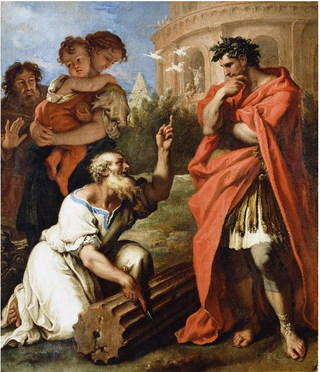
The gens Tarquinia was a plebeian family at ancient Rome, usually associated with Lucius Tarquinius Priscus and Lucius Tarquinius Superbus, the fifth and seventh Kings of Rome. Most of the Tarquinii who appear in history are connected in some way with this dynasty, but a few appear during the later Republic, and others from inscriptions, some dating as late as the fourth century AD.
Gaius Papirius was pontifex maximus in 509 BC, the first year of the Roman Republic. He copied the religious ordinances established by Numa Pompilius, the second King of Rome, which his grandson, Ancus Marcius, had carved on oaken tablets, and placed in the Forum.

Sextus Tarquinius was one of the sons of the last king of Rome, Lucius Tarquinius Superbus. In the original account of the Tarquin dynasty presented by Fabius Pictor, he is the second son, between Titus and Arruns. However, according to Livy and Dionysius of Halicarnassus, he was either the third or first son, respectively. According to Roman tradition, his rape of Lucretia was the precipitating event in the overthrow of the monarchy and the establishment of the Roman Republic.

The Tragedy of Lucretia is a tempera and oil painting on a wood cassone or spalliera panel by the Italian Renaissance master Sandro Botticelli, painted between 1496 and 1504. Known less formally as the Botticelli Lucretia, it is housed in the Isabella Stewart Gardner Museum of Boston, Massachusetts, having been owned by Isabella Stewart Gardner in her lifetime.

Lucius Tarquinius Ar. f. Ar. n. Collatinus was one of the first two consuls of the Roman Republic in 509 BC, together with Lucius Junius Brutus. The two men had led the revolution which overthrew the Roman monarchy. He was forced to resign his office and go into exile as a result of the hatred he had helped engender in the people against the former ruling house.

Arruns Tarquinius, commonly called Egerius, was a member of the royal family of early Rome.

Spurius Lucretius Tricipitinus is a semi-legendary figure in early Roman history. He was the first Suffect Consul of Rome and was also the father of Lucretia, whose rape by Sextus Tarquinius, followed by her suicide, resulted in the dethronement of King Lucius Tarquinius Superbus, therefore directly precipitating the founding of the Roman Republic. It is believed that Lucretius and his accomplishments are at least partly mythical and most ancient references to him were penned by Livy and Plutarch.

Lucretia and her Husband Lucius Tarquinius Collatinus or Tarquin and Lucretia is an oil painting attributed to Titian, dated to around 1515 and now in the Kunsthistorisches Museum in Vienna. The attribution to this artist is traditional but uncertain - the brightened palette suggests it could instead be by Palma Vecchio. However, others identify the painting as part of Titian's series of half-length female figures from 1514 to 1515, which also includes the Flora at the Uffizi, the Woman with a Mirror at the Louvre, the Violante and the Young woman in a black dress in Vienna, Vanity in Munich and the Salome at the Galleria Doria Pamphilj. There is an early copy in the Royal Collection.

Tarquin and Lucretia is an oil painting by Titian completed in 1571, when the artist was in his eighties, for Philip II of Spain. It is signed, and considered to have been finished entirely by Titian himself. It is one of a series of great works from Titian's last years, but unlike some of these, is fully finished. It is now in the Fitzwilliam Museum in Cambridge, England.
The overthrow of the Roman monarchy was an event in ancient Rome that took place between the 6th and 5th centuries BC where a political revolution replaced the then-existing Roman monarchy under Lucius Tarquinius Superbus with a republic. The details of the event were largely forgotten by the Romans a few centuries later; later Roman historians presented a narrative of the events, traditionally dated to c. 509 BC, but it is largely believed to be fictitious by modern scholars.
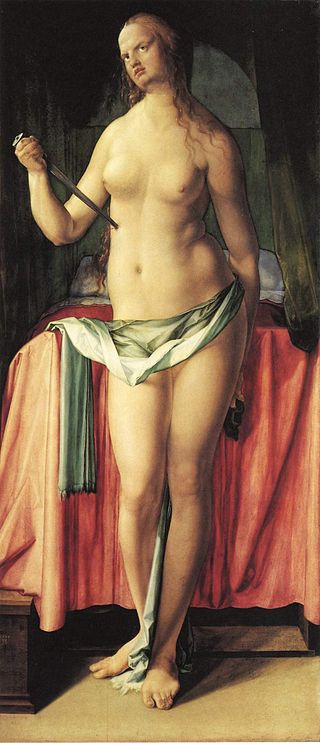
The Suicide of Lucretia is an oil on lime panel painting by Albrecht Dürer, signed and dated 1518, in the collection of the Alte Pinakothek, Munich. It shows the Ancient Rome heroine Lucretia, wife of Lucius Tarquinius Collatinus, in a tall and narrow framing, in the act of killing herself rather than face the shame of being raped by her cousin Sextus Tarquinius.
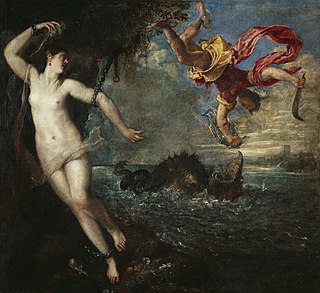
Perseus and Andromeda is a painting by the Italian Renaissance artist Titian, now in the Wallace Collection, in London. It was painted in 1554–1556 as part of a series of mythological paintings called "poesie" ("poetry") intended for King Philip II of Spain. The paintings took subjects from the Roman poet Ovid's Metamorphoses, in this case Book IV, lines 663–752, and all featured female nudes.

Tarquin and Lucretia is a 1620–1650 oil on canvas painting by Artemisia Gentileschi. It hangs in the Great Hall of the Neues Palais in Potsdam. It is one of three paintings that Gentileschi painted of Lucretia, the wife of Roman consul and general Tarquinus, at the moment of her suicide. The other two versions are in a private collection in Milan and The Getty Museum in Los Angeles.
Tarquin and Lucretia is a 1571 painting by Titian, now in the Fitzwilliam Museum, Cambridge.

Lucretia and Tarquin is a 1663 oil painting by Luca Giordano of the legendary rape of Lucretia by Sextus Tarquin, as told by Livy and Ovid, which is now in the Museo di Capodimonte in Naples.


